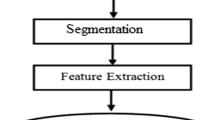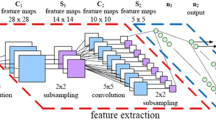Abstract
Offline handwritten word recognition assumes an imperative part in the domain of document analysis and recognition. This article describes a technique for the recognition of offline handwritten Gurumukhi words. The proposed system uses a holistic approach to recognize a word, where a word itself is considered as an individual item. Thus, the word is recognized without considering any explicit segmentation. A set of features, i.e. zoning features, diagonal features, intersection & open-end point features is considered to extract the desirable characteristics from the word images. The classification techniques like k-Nearest Neighbor (k-NN), Support Vector Machine (SVM) and Random forest classifiers are employed for the recognition purpose. To boost the system performance, majority voting scheme of all the considered classifiers and an ensemble algorithm i.e. AdaBoost (Adaptive Boosting) algorithm are used. This system is evaluated on the database comprising 1,00,000 samples of 100 different city names handwritten in Gurumukhi script. Maximum recognition accuracy of 88.78% has been achieved using AdaBoost methodology and the attained results are comparable with state-of-the-art results.








Similar content being viewed by others
References
Adak C, Chaudhuri BB, Blumenstein M (2016) Offline Cursive Bengali Word Recognition using CNNs with a Recurrent Model. Proceedings of the 15th International Conference on Frontiers in Handwriting Recognition,429–434
Arani SAAA, Kabir E, Ebrahimpour R (2019) Handwritten Farsi word recognition using NN-based fusion of HMM classifiers with different types of features. Int J Image Graph 19(1):1–21
Assayony MO, Mahmoud SA (2017) Integration of Gabor features with bag-of-features framework for Arabic handwritten word recognition. Proceedings of the 9th IEEE-GCC Conference and Exhibition (GCCCE), 1-4
Bhowmik S, Malakar S, Sarkar R, Nasipuri M (2014) Handwritten Bangla word recognition using elliptical features. Proceedings of the 6th International Conference on Computational Intelligence and Communication Networks, 257-261
Bhunia AK, Roy PP, Mohta A, Pal U (2018) Cross-language framework for word recognition and spotting of Indic scripts. Pattern Recogn 79:12–31
Bhunia AK, Das A, Bhunia AK, Kishore PSR, Roy PP (2019) Handwriting recognition in low-resource scripts using adversarial learning. Proceedings of IEEE/CVF Conference on Computer Vision and Pattern Recognition (CVPR), 4762-4771
Bhunia AK, Mukherjee S, Sain A, Bhunia AK, Roy PP, Pal U (2020) Indic handwritten script identification using offline-online multi-modal deep network. Inf Fusion 57:1–14
Dasgupta J, Bhattacharya K, Chanda B (2016) A holistic approach for off-line handwritten cursive word recognition using directional feature based on Arnold transform. Pattern Recogn Lett 79:73–79
Dehghan M, Faez K, Ahmadi M, Shridhar M (2001) Handwritten Farsi (Arabic) word recognition: a holistic approach using discrete HMM. Pattern Recogn Lett 34(5):1057–1065
Dutta K, Krishnan P, Mathew M, Jawahar CV (2018) Offline handwriting recognition on Devanagari using a new benchmark dataset. Proceedings of 13th IAPR International Workshop on Document Analysis Systems, 25-30
Ghosh M, Malakar S, Bhowmik S, Sarkar R, Nasipuri M (2019) Feature selection for handwritten word recognition using Memetic algorithm. In: Mandal J, Dutta P, Mukhopadhyay S (eds) Advances in Intelligent Computing. Stud Comput Intell 687:103–124
Gowda PK, Chethan S, Harsha J, Rakesh J, Tanushree KN (2017) Offline Kannada handwritten word recognition using locality preserving projections (LPP). Int J Innov Res Comput Commun Eng Projections 5(5):9955–9960
Hu H, Li Y, Zhu Z, Zhou G (2018) CNNAuth: continuous authentication via two-stream convolutional neural networks. Proceedings of IEEE 13th International Conference on Networking, Architecture and Storage (NAS), 1-9
Imani Z, Ahmadyfard AR, Zohrevand A (2016) Holistic Farsi handwritten word recognition using gradient features. J Artif Intell Data Min 4(1):19–25
Jayech K, Mahjoub M, Amara NB (2016) Arabic handwritten word recognition based on dynamic Bayesian network. Int Arab J Inf Technol 13(6B):1024–1031
Kadhm MS, Hassan AKA (2015) Handwriting word recognition based on SVM classifier. Int J Adv Comput Sci Appl 6(11):64–68
Kaur H, Kumar M (2018) A comprehensive survey on word recognition for non-Indic and Indic scripts. Pattern Anal Applic 21:897–929
Kaur H, Kumar M (2019) Benchmark dataset: offline handwritten Gurmukhi City names for postal automation. In: Sundaram S, Harit G (eds) Document Analysis and Recognition. DAR 2018. Commun Comput Inf Sc 1020:152–159
Kessentini Y, Paquet T, Hamadou AMB (2010) Off-line handwritten word recognition using multi-stream hidden Markov models. Pattern Recogn Lett 31(1):60–70
Khemiri A, Echi AK, Belaid A, Elloumi M (2016) A system for off-line Arabic handwritten word recognition based on Bayesian approach. Proceedings of the 15th International Conference on Frontiers in Handwriting Recognition, 560-565
Kumar S (2016) A study for handwritten Devanagari word recognition. Proceedings of the International Conference on Communication and Signal Processing, 1009-1014
Kumar M, Chandran S (2015) Handwritten Malayalam word recognition system using neural networks. Int J Eng Res Technol (IJERT) 4(4):90–99
Kumar N, Gupta S (2018) Offline handwritten Gurmukhi word recognition using deep neural networks. Int J Pure Appl Math 119(12):14749–14767
Kumar M, Sharma RK, Jindal MK (2014a) Efficient feature extraction techniques for offline handwritten Gurmukhi character recognition. Natl Acad Sci Lett 37(4):381–391
Kumar M, Jindal MK, Sharma RK (2014b) A novel hierarchical technique for offline handwritten Gurmukhi character recognition. Natl Acad Sci Lett 37:567–572
Kumar M, Jindal MK, Sharma RK, Jindal SR (2016) Offline handwritten pre-segmented character recognition of Gurmukhi script. Mach Graph Vis 25(1):45–55
Kumar M, Jindal MK, Sharma RK, Jindal SR (2019) Character and numeral recognition for non-Indic and Indic scripts: a survey. Artif Intell Rev 52:2235–2261
Li Y, Hu H, Zhou G (2019) Using data augmentation in continuous authentication on smartphones. IEEE Internet Things J 6(1):628–640
Li Y, Hu H, Zhu Z, Zhou G (2020a) SCANet: sensor-based continuous authentication with two-stream convolutional neural networks. ACM Trans Sensor Netw 16(3):1–26
Li Y, Zou B, Deng S, Zhou G (2020b) Using feature fusion strategies in continuous authentication on smartphones. IEEE Internet Comput 24(2):49–56
Mhiri M, Desrosiers C, Cheriet M (2018) Convolutional pyramid of bidirectional character sequences for the recognition of handwritten words. Pattern Recogn Lett 111:87–93
Pal U, Roy K, Kimura F (2009) A lexicon-driven Handwritten City name recognition scheme for Indian postal automation. IEICE Trans Inf Syst E92.D(5):1146–1158
Pal U, Roy RK, Kimura F (2011) Handwritten street name recognition for Indian postal automation. Proceedings of International Conference on Document Analysis and Recognition, 483-487
Pal U, Roy RK, Kimura F (2012) Multi-Lingual City name recognition for Indian postal automation. Proceedings of International Conference on Frontiers in Handwriting Recognition, 169-173
Patel C, Desai A (2011) Zone identification for Gujarati handwritten word. Proceedings of the second International Conference on Emerging Applications of Information Technology, 194-197
Patel MS, Reddy SC (2014) An impact of grid based approach in offline handwritten Kannada word recognition. Proceedings of the International Conference on Contemporary Computing and Informatics (IC3I), 630-633
Patel MS, Kumar R, Reddy SC (2015) Offline Kannada handwritten word recognition using locality preserving projection (LPP) for feature extraction. Int J Innov Res Sci Eng Technol 4(7):5078–5086
Roy PP, Chherawala Y, Cheriet M (2014) Deep-Belief-Network based Rescoring for Handwritten Word Recognition. Proceedings of the 14th International Conference on Frontiers in Handwriting Recognition,506–511
Roy PP, Bhunia AK, Das A, Dey P, Pal U (2016) HMM-based Indic handwritten word recognition using zone segmentation. Pattern Recogn 60:1057–1075
Shaw B, Bhattacharya U, Parui SK (2015) Offline handwritten Devanagari word recognition: information fusion at feature and classifier levels. Proceedings of 3rd IAPR Asian Conference on Pattern Recognition, 720-724
Tamen Z, Drias H, Boughaci D (2017) An efficient multiple classifier system for Arabic handwritten words recognition. Pattern Recogn Lett 93:123–132
Tavoli R, Keyvanpour M, Mozaffari S (2018) Statistical geometric components of straight lines (SGCSL) feature extraction method for offline Arabic/Persian handwritten words recognition. IET Image Process 12:1606–1616
Thadchanamoorthy S, Kodikara ND, Premaretne HL (2013) Tamil Handwritten City name database development and recognition for postal automation. Proceedings of the 12th International Conference on Document Analysis and Recognition, 793-797
Turk M, Pentland A (1991) Eigen faces for recognition. J Cogn Neurosci 3(1):71–86
Zhang TY, Suen CY (1984) A fast parallel algorithm for thinning digital patterns. Commun ACM 27(3):236–239
Author information
Authors and Affiliations
Corresponding author
Ethics declarations
Conflict of interest
Authors have no conflict of interest.
Additional information
Publisher’s note
Springer Nature remains neutral with regard to jurisdictional claims in published maps and institutional affiliations.
Rights and permissions
About this article
Cite this article
Kaur, H., Kumar, M. On the recognition of offline handwritten word using holistic approach and AdaBoost methodology. Multimed Tools Appl 80, 11155–11175 (2021). https://doi.org/10.1007/s11042-020-10297-7
Received:
Revised:
Accepted:
Published:
Issue Date:
DOI: https://doi.org/10.1007/s11042-020-10297-7




